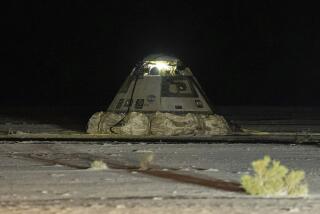Shuttle Flight Scrubbed as Rocket Fails : Launch Canceled 15 Seconds Before Liftoff; Rescheduled for Jan. 4
KENNEDY SPACE CENTER, Fla. — The United States’ last manned orbital flight of the year was scrubbed 15 seconds short of liftoff Thursday when trouble appeared in one of the giant booster rockets that help drive the space shuttle into orbit.
Disappointed officials of the National Aeronautics and Space Administration rescheduled the launch for Jan. 4, bringing to 15 the number of shuttle launchings to be attempted next year.
It was the second postponement of the flight, a five-day mission that will launch a powerful new RCA Communications television transmission satellite.
Crew Disappointed
Mission commander Robert L. Gibson said members of the seven-man crew had been awaiting the roar of the shuttle engines when a ground-based computer stopped the countdown.
“It goes without saying,” he told reporters, “we were disappointed.”
The halt in the launching was triggered by excessive revolutions per minute in a gas turbine generating hydraulic pressure to maneuver the engine on one of the two solid rocket boosters.
Two of the solid fuel rockets, generating more than a million pounds of thrust each, help lift the shuttle to 150,000 feet before their expended casings fall into the sea.
Their flight path is controlled by swiveling their engines with the hydraulic system.
Robert Sieck, Kennedy Space Center’s director of shuttle operations, said the flight would have reached orbit successfully because the faulty hydraulic power unit has an identical backup generator that would have taken over when the faulty unit shut down. But mission rules require that both units be operating properly at the time of launch. Thus, when one of the turbines exceeded 79,200 rpm, ground-based computers automatically stopped the countdown.
Nelson Among Crew
The astronauts were not in danger, but they and members of the launch-control team began a rapid series of safety precautions. Crew members, including Rep. Bill Nelson (D-Fla.), left the shuttle half an hour later.
Initially, the flight was scheduled for Wednesday, but it was delayed 24 hours when launch teams fell behind schedule in their preparations.
Until the last minutes of the countdown Thursday morning, it appeared that the flight might be delayed by low clouds.
Flight directors in Houston were able to extend the launch “window” by about 20 minutes, however, giving further opportunity for clouds to break up.
Until the countdown was interrupted, just four seconds before Columbia’s on-board computer was to receive orders to start engines, there had been no hint of technical trouble.
Sieck said the vehicle could have been prepared for launch during the week after Christmas, but a decision was made to go ahead with a long-planned holiday vacation for NASA contractor employees.
More to Read
Sign up for Essential California
The most important California stories and recommendations in your inbox every morning.
You may occasionally receive promotional content from the Los Angeles Times.










